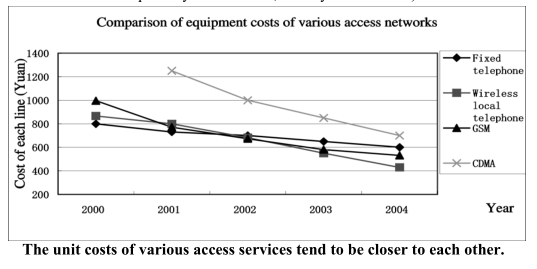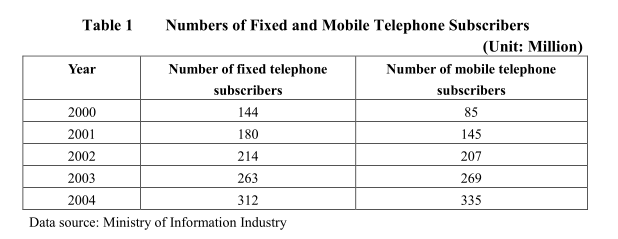Loosening Control over Telecom Charges to Promote Competition in the Telecom Sector
Sep 01,2005
Ma Jun, Enterprise Research Institute of DRC Research Report No.011, 2005
Although a competitive market structure has taken shape in China’s telecommunication industry, the regulation reform lags relatively behind. Two main factors have facilitated the formation of a competitive market structure. One is the government-led market structure reform, including several times of industrial restructuring and the lowering of market access threshold. The other is the advancement of telecommunication technologies, wherein new technologies and new services have promoted competition, especially competition between different services. The change in market structure requires the regulatory agency to adjust its regulatory policies, in particular, to loosen its control over telecom charges and to give full play to market competition.
I. Fixed Telephone Services Are Becoming Potential Market for Competition
Fixed local telephone services have long been regarded as a market where natural monopoly exists. But in fact, fixed telephone services have, on the whole, basically possessed potential competitive characteristics due to technical advancement.
1. Competition exists to some degree among fixed telephone operators
Generally speaking, direct competition among fixed telephone operators is very little. In fixed services market, two fixed telephone service providers, i.e., China Telecom and China Netcom, have monopoly respectively on the north and the south markets, and the monopoly is mainly on the access of existing subscribers. But the access of new subscribers and some high-density subscribers is basically competitive.
A misconception long existent in the past was the attempt to introduce competition among fixed telephone operators, with the purpose to eliminate monopoly on local line loop. The telecom reform started from 1996 in the United States proved that, the introduction of competition in local line loop via the network elements with unbundling approach yields little results. None but the popularization of other access modes and rapid technical advancement are effective ways to break the monopoly on local line loop.
2. Mobile communication is becoming the direct competitor of fixed telephone service
The trend of substituting mobile services for fixed services is becoming stronger and stronger. When the cost of mobile communication is far higher than that of fixed telephone, the role of mobile communication in replacing fixed telephone is not so obvious as it should be. With the rapid reduction in the cost of mobile communication and the change in the habits of subscribers, the substitution of mobile communication for fixed telephone becomes more obvious.
The network cost of mobile communication is more and more approximate to that of fixed telephone. With respect to the unit cost of accessing network, the cost of mobile telephone is far higher than that of fixed telephone in its early stage of development. The rapid advancement of technologies results in rapid reduction in the unit cost of mobile telephone, while that of traditional fixed telephone reduces much slower. For the time being, the unit costs of mobile and fixed telephones are almost the same. The equipment costs of each line in accessing network of mobile communication and fixed telephone are comparable to a certain extent (for wireless network, consideration shall be given to its utilization ratio, and the equipment cost of each line shall be multiplied by a coefficient, usually less than 1.5).

Note: The cost is the average price estimated based on data collected by the author from the market, which is mainly used to reflect the trend of development.
Cost of each line includes exchange equipment. It is assumed that the wireless local telephone adopts mobile exchange equipment.
The price of mobile terminal has dropped to a level acceptable to ordinary subscribers. Most of the mobile handsets in the market are priced at about 1000 yuan, and low-end handsets cost only several hundred yuan. Still, the rise of domestic mobile handset manufacturers and the intensification of market competition will further push the rapid price reduction.

The number of mobile telephone subscribers has exceeded that of fixed telephone subscribers, and the consumption habits of telecom subscribers have changed greatly. Consumers, especially young consumers, depend more and more on mobile communication, and the habits of subscribers will make significant impact to market competition.
3.Wireless local access service poses direct competition to fixed telephone service
Now there is not much difference between the charges of wireless local access service and fixed telephone service. Besides, the wireless local access service is also provided with certain mobility and therefore, its substitution for fixed phones is rather prominent. By the end of 2004, the capacity of wireless local access lines across the country had reached close to 90 million, and the number of subscribers approached 70 million. The wireless local access service is a main service sector for fixed telephone operators.
4.Various new services constitute certain competition to fixed telephone service
IP telephones have replaced most of the traditional long-distance telephones. Both telephones have identical voice quality, but the rate of IP telephone is much lower.
Voice communication based on data network is gaining rapid development. China’s broadband access is being popularized rapidly, especially in cities. By year 2004, the number of broadband subscribers across the country had already reached 23.85 million. The broadband data subscribers only need to install a freeware in the terminal before they have free access to voice communication in the data network (they need to pay the local access fee ), including local telephone, DDD and IDD.
The various wireless access services now emerging are also the potential competitors of fixed telephone services.
Various short message services including handset short message service, Internet short message service and electronic mail service also diverted some fixed traffic volume.
…
If you need the full text, please leave a message on the website.














